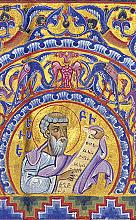Founding fathers

[Alexander Melville, Charles Haddon Spurgeon, 1885. Oil on canvas, National Portrait Gallery, London—Public domain, Wikimedia]
These men from our top 10 most searched figures founded movements and gained large followings.
Father of a new revivalism
Young Charles Finney (1792–1875) studied law, but one day in 1821 decided to settle the question of his soul’s salvation. Alone in the woods, he wrestled with God in prayer. The next morning Finney closed his law office: he was leaving to become a preacher. A presbytery licensed him to preach in December 1823.
As an itinerant preacher, Finney’s early meetings in upper New York state produced a remarkable crop of converts but he did not plan to remain a traveling evangelist. After he and Lydia Andrews wed in 1824, he considered taking a permanent pastorate.
However, Finney’s path took an unexpected turn in 1825 when his former pastor, George Gale, asked Finney to preach. Crowds flocked to hear him, and many people sought assurance of conversion. Newspapers noticed. Finney attracted supporters, including Lewis and Arthur Tappan, prominent New York merchants.
Finney met opposition as well. Old School Presbyterians denounced his modified Calvinism. Congregationalists said that Finney invited fanaticism by allowing too much human emotion. Unitarians and Universalists alleged he used scare tactics to gain converts. Controversy also erupted over “new measures” Finney employed. He allowed women to pray in public, used an “anxious bench” at the front of the church, held protracted (daily) meetings, prayed informally, and admitted new converts immediately to church membership.
The zenith of Finney’s evangelistic career came at Rochester, New York, where his 1830–1831 meetings consumed the city. Finney made his case like a lawyer before a jury. People from all walks of life responded.
Shortly after the Rochester campaign, Finney accepted a New York City pastorate. There he published his Lectures on Revivals of Religion. This book claimed that revival is not a miracle, but the right use of means. Professor Charles Hodge of Princeton Seminary condemned it. Finney became a leader of the New School Presbyterians and of the free church movement—congregations that rejected pew rents in favor of free seating. Friends built the Broadway Tabernacle for Finney, open to everyone.
Finney became a professor at Oberlin College in Ohio in 1835 at the invitation of antislavery students. The Tappans agreed to underwrite his costs. He taught pastoral theology and wrote for the Oberlin Evangelist but continued to conduct revival meetings. Finney drew Oberlin into social reforms such as the temperance movement, women’s education, and abolitionism. Oberlin even became a station on the Underground Railroad and the scene of the dramatic rescue of an enslaved man. Finney encouraged antislavery action but cautioned Christians not to allow reform efforts to replace revivalism.
Troubled by the number of backsliders, Finney and Oberlin College president Asa Mahan formulated a heavily criticized doctrine of Christian perfectionism.
On December 18, 1847, Lydia died, leaving five children from ages three to nineteen. Finney soon married Elizabeth Ford Atkins, a widow. The Finneys visited England twice in the 1850s, where Finney successfully led revivals. Elizabeth held women’s meetings, starting a trend.
Finney continued at Oberlin College. Friends urged him to write about the revivals he had conducted. These Memoirs are still popular. Charles Finney died at dawn on Monday, August 16, 1875. His methods paved the way for later revivalists like Dwight L. Moody, Billy Sunday, and Billy Graham.—James E. Johnson, from CH #20
Prince of preachers
When Charles Haddon Spurgeon died in January 1892, London mourned. Flags flew at half-mast, shops closed. A funeral parade two miles long followed his hearse. One hundred thousand people stood along the way.
Spurgeon was born in 1834 in Kelvedon, Essex. His father and his grandfather were dissenters—ministers outside the Church of England. His earliest memories included learning hymns and looking at the pictures in The Pilgrim’s Progress and Foxe’s Book of Martyrs (which he later called “the perfect Christmas gift for a child.”)
As a dissenter Spurgeon could not take a degree at any major national university. Nonetheless he became a literate man with a personal library of 12,000 volumes.
Spurgeon attributed his conversion to a sermon he heard by chance when a snowstorm diverted him into a Primitive Methodist chapel. He became a Baptist, convinced that infant baptism, practiced by his father and grandfather, is unscriptural. His mother responded, “I often prayed the Lord to make you a Christian, but I never asked that you might become a Baptist.”
His first pastorate was in the village of Waterbeach near Cambridge. Even then he had star quality and was known as “the boy wonder of the fens.” He appeared even younger than he was, a startling contrast to the maturity of his sermons, which were strongly influenced by Puritan works. His youth, energy, command of old texts, and oratorical skills made a vivid impact upon his listeners.
His reputation spread to London, and in 1854 historic New Park Street Chapel invited him to preach. The 19-year-old country boy moved to the city.
Britain experienced economic and social distress in the 1850s. Not coincidentally the decade ended with the “Great Revival,” which began in Ireland and Scotland and swept into England, igniting religious emotions not felt since the days of Wesley and Whitefield.
As Spurgeon preached throughout the kingdom, no chapel was large enough to hold everyone who wanted to hear him. Until his congregation moved to the Metropolitan Tabernacle, he rented London’s great secular halls—Exeter Hall, Surrey Gardens Music Hall, the Agricultural Hall—where he preached to thousands.
Some of Spurgeon’s popularity may be because church-going was one of the few Sunday diversions permitted in evangelical homes. And Spurgeon was a charismatic speaker. Photographs show him in dramatic poses. Visitors said he assumed the identity of biblical characters. His dramatic devices are commonplace now. But critics called him “a clerical poltroon” and “the pulpit buffoon.”
Spurgeon’s congregation adored him. When Spurgeon stood on his platform in the Tabernacle, he looked out at the largest Protestant congregation in the world.
In 1856 Spurgeon married pretty, stylish Susannah Thompson. She had hesitated, finding the young preacher countrified. After a Paris honeymoon, they became the parents of twin sons. Husband and wife suffered periodic invalidism, but they remained devoted lovers.
In the 1880s Spurgeon noted that some Baptists no longer subscribed to sound doctrines such as scriptural infallibility and the atonement. The “Down-Grade Controversy,” as it was known, darkened Spurgeon’s last years.
He was not an original thinker. His originality lay in his ability to combine old-fashioned doctrine with up-to-date delivery. “I must and I will make the people listen,” the boy preacher had said. None did it better.—Patricia Stallings Kruppa, from CH #29
Father of modern missions
Long before his death at age 73, William Carey (1761–1834) had become an almost mythic figure. Acquaintances collected relics from his early life: a cup from which he had drunk, shoes he had made, a wooden advertisement. Carey would have none of it. When he lay dying in 1834, he summoned fellow missionary Alexander Duff to his side and whispered,
Mr. Duff! You have been speaking about Dr. Carey, Dr. Carey; when I am gone, say nothing about Dr. Carey. Speak about Dr. Carey’s Savior.
In spite of Carey’s protestations, Christians have continued to be interested not only in Carey’s Savior, but also in Carey. More than 50 biographies of him have been published. Universities, mission societies, and publishing houses are named for him. Carey and the Serampore Mission were widely imitated catalysts for the Great Missions Century.
His plan to evangelize India had three parts: preach the gospel, translate the Bible, and establish schools. By 1817 the Serampore missionaries had opened 103 schools with an average combined attendance of 6,703. Among the wide range of subjects taught was Bible instruction. The crowning work of Carey’s educational career was Serampore College, which he cofounded in 1818. English missionaries would never be able to evangelize all India. Thus Serampore was founded to provide both liberal arts and theological education, so Indians could reach their own.
Carey pioneered cross-cultural communication. His willingness to translate the Bible into the vernacular and to translate Hindu writings into English showed remarkable respect for Indian culture. He himself was responsible for translating the entire Bible into Bengali, Oriya, Marathi, Hindi, Assamese, and Sanskrit, as well as portions of it into 29 other tongues. Bible translations provided a valuable tool for evangelists.
Each year on his birthday, Carey took stock of his life. “If ever I get to heaven,” he said, “it must be owing to divine grace from first to last.” In 1831 he declared,
I am this day 70 years old, a monument of Divine mercy and goodness, though on a review of my life I find much, very much, for which I ought to be humbled in the dust.—Timothy George, from CH #36 CH
By James E. Johnson, Patricia Stallings Kruppa, Timothy George
[Christian History originally published this article in Christian History Issue #150 in 2024]
James E. Johnson (1927–2019) was emeritus professor of history at Bethel University. Patricia Stallings Kruppa was associate professor of history at the University of Texas at Austin. Timothy George was founding dean of Beeson Divinity School and is executive editor at Christianity Today.Next articles
Surprised by Christ
Three spirits conquered by Christ
Lyle W. Dorsett, Matt Forster, Kaylena RadcliffRussian Christianity and the revolution: what happened?
The sins of the church came back on its head with a fury
Andrew SorokowskiSupport us
Christian History Institute (CHI) is a non-profit Pennsylvania corporation founded in 1982. Your donations support the continuation of this ministry
Donate







